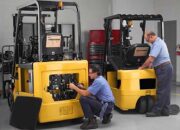The Most Common Types of Forklifts in Modern Logistics
In the relentless pace of the global supply chain, logistics and warehouse management serve as the lifeblood, determining the success or failure of a business. One of the greatest challenges every warehouse faces is how to optimize space, accelerate material handling, and ensure absolute safety. The solution to this complex puzzle lies in a familiar yet critical piece of equipment: the forklift.
The Importance of Forklifts in Logistics and Warehouse Management
Investing in an appropriate forklift system is not merely about acquiring machinery; it is an investment in operational efficiency.
Increased Operational Speed: Forklifts significantly reduce the time required for loading/unloading goods and containers, minimizing vehicle waiting times and speeding up the entire supply chain process.
Optimized Storage Space: Instead of relying solely on floor space, forklifts enable vertical storage by stacking goods on high racking systems, dramatically increasing storage density.
Reduced Labor and Costs: A single forklift can replace the manual labor of multiple workers, allowing businesses to save significantly on labor costs and allocate resources to higher-skill tasks.
Enhanced Workplace Safety: Manual handling of heavy goods poses significant risks of accidents. Forklifts minimize these risks, creating a safer working environment.
Classification of the Most Common Forklift Types
To choose the right partner for your warehouse, you first need to understand the world of forklifts. They are primarily classified in two ways: by fuel type and by design or specific functionality.
Forklift Classification by Fuel Type
- Electric Forklifts
Characteristics: Powered entirely by batteries, producing zero emissions and operating quietly.
Applications: The top choice for indoor environments, sealed warehouses, and industries with stringent hygiene standards, such as food, pharmaceuticals, electronics, and cold storage.
Advantages: Environmentally friendly, low energy costs, near-silent operation, and minimal engine maintenance.
Disadvantages: Higher initial investment, downtime required for battery recharging (which may interrupt operations), and generally lower lifting capacities compared to diesel forklifts.
- Diesel Forklifts
Characteristics: Equipped with powerful internal combustion engines, offering superior lifting capacity and durability in the harshest conditions.
Applications: The “king” of outdoor operations, ideal for construction sites, seaports, heavy material manufacturing plants, and any environment requiring the handling of large loads on rough terrain.
Advantages: Exceptional power, unrestricted operating time (with refueling), and versatility across all terrains.
Disadvantages: Noisy, emits exhaust fumes, making them unsuitable for enclosed spaces, and requires more complex engine maintenance.
- Gas/LPG Forklifts
Characteristics: A balanced hybrid between the power of diesel forklifts and the cleanliness of electric models.
Applications: Highly versatile, suitable for both indoor (with adequate ventilation) and outdoor tasks. Quick gas cylinder replacement ensures near-continuous operation.
Advantages: Stronger than electric forklifts, cleaner than diesel, with moderate investment and operating costs.
Disadvantages: Requires dedicated storage for gas cylinders with strict fire safety measures.
Forklift Classification by Design and Functionality
- Hand Pallet Trucks
The most basic and widely used type, including low-lift pallet trucks for moving pallets across the floor and high-lift versions for stacking goods on low racks or loading trucks (up to 1-3 meters). They are indispensable for short-distance material handling in confined spaces.
- Counterbalance Forklifts
The iconic image of a forklift, featuring a metal counterweight at the rear for stable lifting and transporting of heavy pallets. These are the most versatile forklifts, capable of performing tasks from container loading/unloading to warehouse organization. Available in electric, diesel, and gas variants.
- Reach Trucks
As the name suggests, reach trucks excel at high-level operations. Their distinctive feature is a mast that extends forward to retrieve or place pallets deep within racking systems. Designed for narrow aisles, they are ideal for warehouses with high racking systems (6 meters and above).
- Very Narrow Aisle (VNA) Forklifts
When every centimeter of space matters, VNA forklifts are the solution. Their unique ability to rotate forks 90 degrees or shift them side-to-side without turning the entire vehicle allows operation in aisles only slightly wider than the forklift itself, maximizing storage density.
- Order Pickers
Unlike other forklifts that only lift goods, order pickers elevate both the operator and the load. This design is ideal for picking individual items from high shelves (order picking), where workers need to manually select specific products rather than move entire pallets.
Key Factors to Consider When Choosing a Forklift
To navigate the diverse world of forklifts, answer these critical questions before making a decision:
Indoor or outdoor operations? Smooth or rough terrain? This determines whether an electric, diesel, or gas forklift is most suitable.
How heavy are your loads, and how high do they need to be lifted? Clarify the maximum load capacity and lifting height to select a forklift with appropriate strength and mast length.
What is the layout of your warehouse? Aisle width will dictate whether a standard counterbalance forklift, reach truck, or VNA is the best fit.
Consider both initial investment and long-term operating costs (fuel, maintenance, battery charging).
Will the forklift operate 24/7 or just a few hours daily? This affects whether an electric forklift (requiring charging time) or an internal combustion model is more practical.
The market offers a vast array of forklifts, but there is no single “best” type—only the one most suited to your business’s specific needs. Understanding each type and carefully analyzing operational factors is the golden key to unlocking efficiency.
Choosing the right forklift in logistics is not just an investment in equipment; it is an investment in speed, safety, and the competitive edge of your entire supply chain.







